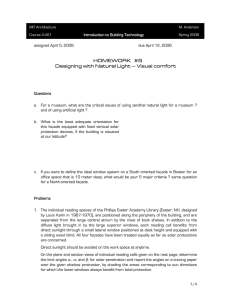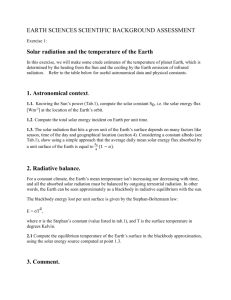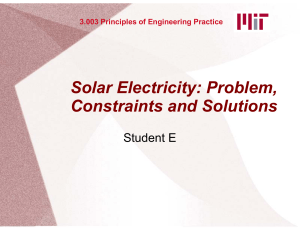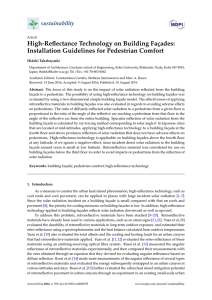HOMEWORK #1 Solar radiation and Climate
advertisement
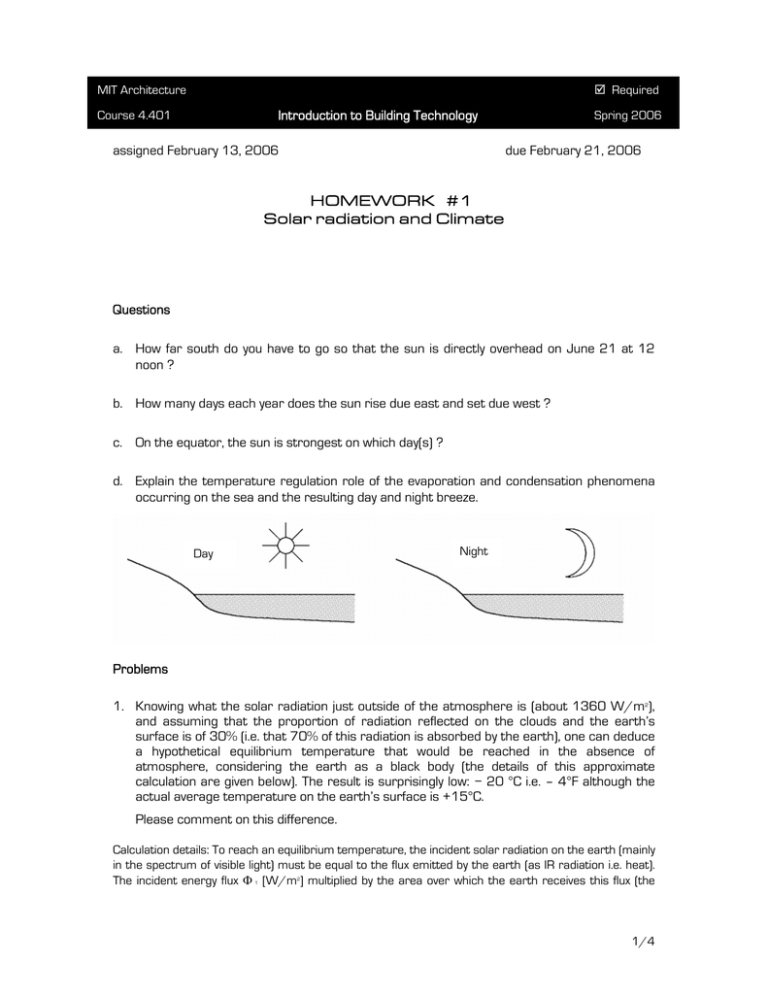
MIT Architecture ; Required Introduction to Building Technology Course 4.401 assigned February 13, 2006 Spring 2006 due February 21, 2006 HOMEWORK #1 Solar radiation and Climate Questions a. How far south do you have to go so that the sun is directly overhead on June 21 at 12 noon ? b. How many days each year does the sun rise due east and set due west ? c. On the equator, the sun is strongest on which day(s) ? d. Explain the temperature regulation role of the evaporation and condensation phenomena occurring on the sea and the resulting day and night breeze. Day Night Problems 1. Knowing what the solar radiation just outside of the atmosphere is (about 1360 W/m2), and assuming that the proportion of radiation reflected on the clouds and the earth’s surface is of 30% (i.e. that 70% of this radiation is absorbed by the earth), one can deduce a hypothetical equilibrium temperature that would be reached in the absence of atmosphere, considering the earth as a black body (the details of this approximate calculation are given below). The result is surprisingly low: − 20 °C i.e. – 4°F although the actual average temperature on the earth’s surface is +15°C. Please comment on this difference. Calculation details: To reach an equilibrium temperature, the incident solar radiation on the earth (mainly in the spectrum of visible light) must be equal to the flux emitted by the earth (as IR radiation i.e. heat). The incident energy flux Φ 1 [W/m2] multiplied by the area over which the earth receives this flux (the 1/4 cross-sectional area of the earth) is given by: J1 = Φ 1 · effective area of earth = 0.70 · π · R2 · 1,367 W/m2 = 1.2·1017 W (π · R2 being the section offered by the globe to the solar radiation, the earth’s radius R being assumed equal to 6370 km). As the earth can be considered as a black body, the emitted energy flux Φ 2 will be a function of the temperature of the earth (Stefan Boltzmann law: Φ 2 (in W/m2) = σ T4 where σ = 5.67 × 10-8 W m-2 K-4 and where T is the temperature in Kelvin). It is to be multiplied by the total surface area of the earth to get the total emitted radiated power (assuming that the whole globe participates in the emission): J2 = Φ 4 2 3 2 −8 2 · surface area of earth = 4 · π · R · σ · TG = 4 · π · (6,370·10 m) · 5.67·10 W/m2K4 · TG4 = 2.9·107 4 4 W/K · TG = = 254 K Setting J 1 = J 2, we find and equilibrium temperature, TG equal to:TG = . i.e. a TG of about − 20 °C or – 4°F. 2. To what latitude is the stereographic projection given below corresponding ? (remember that at noon solar time, the elevation η, latitude L and declination δ are related by η = 90° - L + δ) What are the apparent elevation and azimuth angles of the sun on August 31 at 2pm (i.e. “14h”) ? What time is it and at what apparent elevation is the sun on February 26 if its apparent azimuth is 120° in the referential chosen for the diagram (0° towards North) ? If you have a S-W oriented façade, facing 210° on the referential provided, what day will you have the sun hitting the façade earliest over the year (in solar time) ? If you lived there and looked through that façade, would you always be able to see the sunset ? If not, what days wouldn’t you see it ? What would happen if a skyscraper was built right in front of the façade, at a distance of 200 ft, that was 150 ft high and 50 ft by 50 ft large ? 00 3450 330 150 0 300 g = 100 70 1 800 3 t2 7 14 P No Time: 13 12 11 10 b Fe Jan 7 Dec May 26 9 v2 2250 14 8 15 750 7 16 p Se 2400 6 0 0 90 21 g3 18 5 60 Apr 500 600 t1 2550 4 400 17 Oc 0 ar July 19 June 21 30 19 Au 2700 450 200 20 3000 2850 0 0 M 315 21 16 26 1050 1200 1350 1500 2100 1950 180 0 165 0 Image by MIT OCW. Latitude: .................. 2/4 3. The rooms of the Hotel “Latitude 43”, situated in Saint-Tropez in the South of France and designed by Pingusson in 1932, were configured so that one could benefit as much as possible from both the view and the sunlight. For that purpose, each room comprises a loggia with view on the pinewood towards the south, and a clerestory for the sea view on the north side. The depth of the loggia on the south façade is expected to ensure a maximal sunlight penetration during the winter while minimizing it during the summer. Site Hotel Latitude 43 To assess how the chosen design is performing, you decide to analyze two rooms (A and B) that present slightly different orientations (see drawing). Start by determining the limit angles for solar penetration α1, α2 and β1 on the plane and section views of the rooms (given below). Report the angles on the provided tracing paper over the shadow protractor given on the next page, by darkening the areas corresponding to sun directions for which there is no sunlight penetration. Plan view Room A Room B N General plan view Section view 3/4 0 10 20 30 10 20 30 10 40 40 20 50 50 60 60 30 40 70 70 50 60 80 80 70 80 90 90 Image by MIT OCW. Superpose the projected shadows on the stereographical view below (which corresponds to the latitude 43°N of St-Tropez) for the two room orientations and analyze how the loggia allows to control the sunlight penetration inside the rooms over the year. 18 21 g Au 31 0 2550 Se pt 16 270 23 14 20 0 30 0 40 0 50 0 60 0 70 0 80 0 90 0 12 30 0 45 60 8 10 Oc t 17 2400 0 b Fe Nov 27 D ec 2 1 0 75 0 4 June 21 0 0 r1 0 10 21 0 y Jul 285 0 Ap 300 15 0 90 0 M ar 315 0 6 330 0 0 Ma y2 6 345 Jan 2250 16 26 1050 1200 1350 2100 1500 1950 1800 1650 Image by MIT OCW. Reading assignment from textbook S.V. Szokolay, Introduction to Architectural Science: § 1.3 (i.e. pp. 22-34) Additional readings relevant to lecture topics: "How Buildings Work" by Allen: Chap 1 "Heating Cooling Lighting" by Lechner: § 5.1 - 5.6 + Chap 6 “Sun Wind Light“ by Brown & DeKay: Chap 1A, § 1 - 6 4/4

